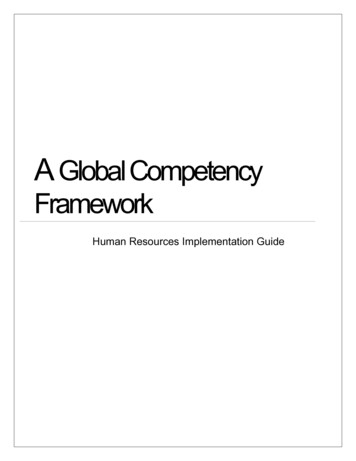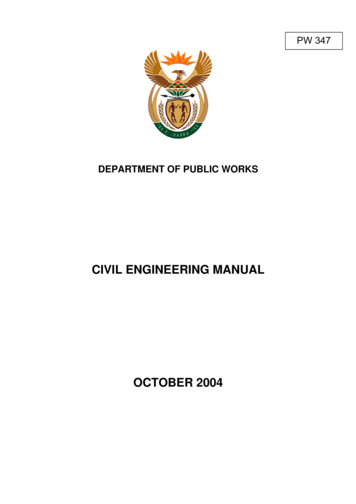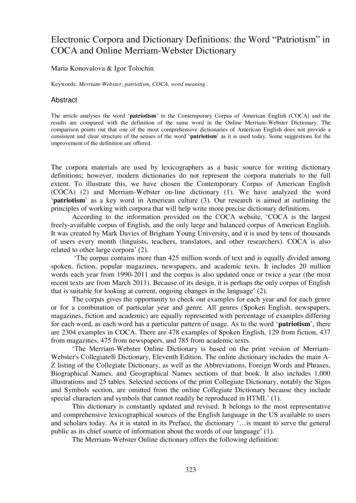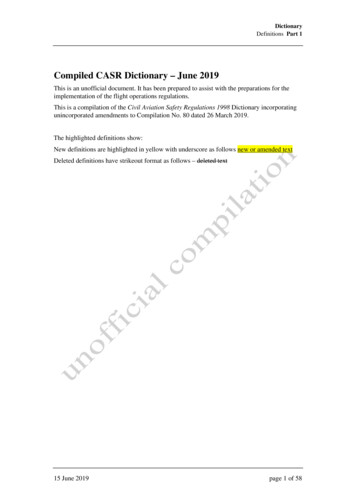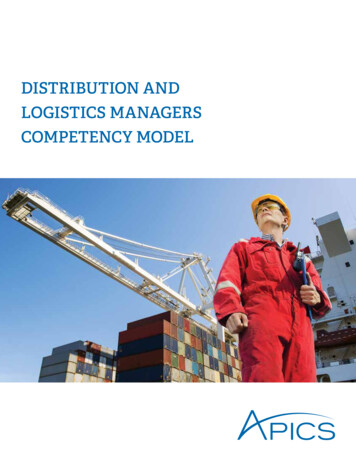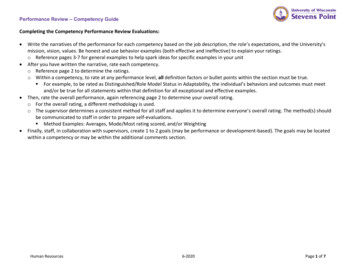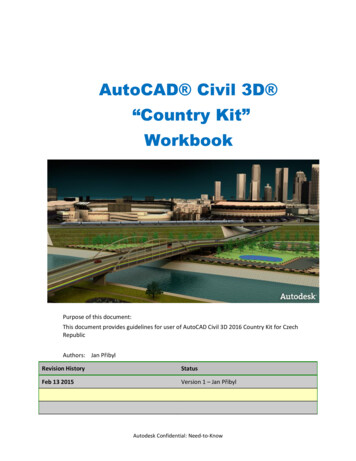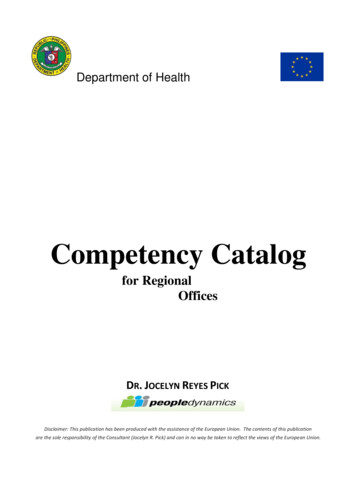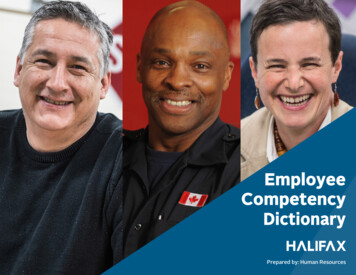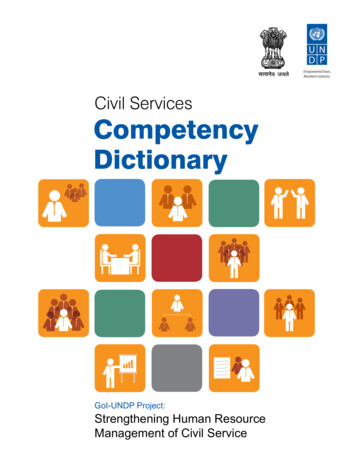
Transcription
Civil ServicesCompetencyDictionaryGoI-UNDP Project:Strengthening Human ResourceManagement of Civil Service
Civil ServicesCompetencyDictionaryGoI-UNDP Project:Strengthening Human ResourceManagement of Civil Service
Hkkjr ljdkjdkfeZd vkSj izf”k{k.k foHkkxdkfeZd] yksd f”kdk;r rFkk isa”ku ea ky;uksFkZ Cykd] ubZ fnYyh & 110001Mk- ,l- ds- ljdkjDr. S. K. SarkarlfpoSecretaryTel : 23094848Fax : 23094500E-mail : sarkardk@nic.inGOVERNMENT OF INDIADEPARTMENT OF PERSONNEL & TRAININGMINISTRY OF PERSONNEL PUBLIC GRIEVANCESAND PENSIONSNORTH BLOCK. NEW DELHI - 110001Website : http://persmin.gov.in26th February, 2014MessageThe National Training Policy (NTP) – 2012 emphasizes that there isan imperative need to move from the current system of rule-basedPersonnel Administration to competency-based system of Strategic HumanResource Management. For a shift towards competency-based approach,it is necessary to classify the distinct types of posts and indicate thecompetencies required for performing work in such posts. NTP-2012stipulates that each Government Department/Ministry should classify eachpost with a clear job description and competencies required.2.It gives me immense pleasure and honour to share with you theCompetency Dictionary for Civil Services along with the implementationtool-kit developed by Department of Personnel and Training (DoP&T) incollaboration with United Nations Development Programme (UNDP). Thecompetency dictionary has been developed after extensive consultationwith various stakeholders including Senior Civil Servants from the Centraland State Government Departments, Cadre Controlling Authorities, PMAward Winners and Training Institutes. This Competency Dictionary couldbe applied to various Human Resource Management functions such astraining, recruitment, performance management, placement andpromotions. The implementation toolkit provides detailed guidelines onhow Departments/Organisations can apply this Competency Dictionary forHRM functions.(Dr. S.K. Sarkar)
MessageThis important compendium aims to support the competency-basedadministrative reforms being introduced by the Government of India. Wehope that officials will find the competency framework, competencydictionary and implementation tool kit included in the compendium useful.We wish to congratulate the Department of Personnel and Training, Ministryof Personnel, Public Grievances and Pensions for its commitment to moreefficient and effective public administration and for the consultative processunderway to introduce the reforms.The United Nations Development Programme is privileged to have supportedthe Department of Personnel and Training, Ministry of Personnel, PublicGrievances and Pensions in the preparation of this Competency Dictionaryfor Civil Services and salutes the Government of India for its steadfastcommitment to public administration reform.Lise GrandeUnited Nations Resident CoordinatorResident Representative United Nations Development Programme
Competency Dictionary for the Civil ServicesContentsIntroduction 8Basic Features of Civil Services 10Competency Framework for the Civil Services 11Competency Definitions 121. Ethos 141.11.21.31.41.5People First 14Strategic Thinking 15Organisational Awareness 16Commitment to the Organisation 17Leading Others 182. Ethics 192.12.22.32.4Integrity 19Self-Confidence 20Attention to detail 21Taking Accountability 223. Equity 233.13.23.33.47Consultation and Consensus Building 23Decision Making 24Empathy 25Delegation 264. Efficiency 274.14.24.34.44.54.64.74.84.94.104.114.12Result Orientation 27Conceptual Thinking 28Initiative and Drive 29Seeking Information 30Planning and Coordination 31Desire for Knowledge 32Innovative Thinking 33Problem Solving 34Developing Others 35Self Awareness and Self Control 36Communication Skills 37Team-Working 38
Competency Dictionary for the Civil ServicesIntroductionIn SummaryAbove The Waterline – Knowledge and SkillThis document will help to understand the process andmethodology for adapting the Civil Services CompetencyDictionary at your organisation.Knowledge is the operational or technical understandinga person has about something and skills are the things aperson can do; for example, keyboarding on a computeror writing a report. Some skills, like thinking about newideas or how to solve a problem, are actually below thewaterline because it’s harder to see someone actuallydoing it.By the end of this section, you would know what is acompetency dictionary and what are the differentelements of a competency.What are Competencies and why are they While knowledge and skills are the most common meansof matching people to jobs, it is important to note thatImportant?rarely do they differentiate performance. Most often, theyCompetencies have been defined in many ways.However, a practical definition of competencies that iseasy to understand, has been defined by Boyatzis (ofHay Group, 1982). It states that competencies are thoseunderlying characteristics of an employee – motive,trait, skill, aspects of one’s social image, social role or abody of knowledge, which can result in effective and/orsuperior performance in a job or role’.This definition can be explained further in the context ofthe Iceberg model, as illustrated and further explainedbelow.SkillKnowledgeSocial RoleSelf ImageTraitsMotives8represent the baseline requirements for a job. They arenecessary but not sufficient conditions or pre-requisitesfor outstanding performance in the role. Excellenceusually depends on the more deep-seated characteristicsof the person.Below The Waterline – Personal CharacteristicsThe other factors related to performance are morepersonal and harder to see in someone, like the rest ofthe iceberg below the waterline. Also, like an iceberg, withmost of the ice below the waterline, the factors below thewaterline are significant drivers of higher performance.Social RoleSocial role relates to how we project ourselves in ourroles. Some doctors, for example, may project the imageof EXPERT by focussing on how much they know aboutsome specialty or how much skill they have at somespecific function. Others may project the image of aHELPER by focussing on what they can do for others.How we choose to project ourselves to others influenceswhere we put emphasis while performing our roles.Self-ImageSelf-image relates to the attitudes and values we hold,what is important to us as individuals, and how we feelabout ourselves. For example, if a person has an attitudeor value that serving customers is important, that personmay be more driven to provide better customer servicethan someone else who doesn’t feel that way.
Competency Dictionary for the Civil ServicesTraitsTraits are the characteristics or consistent responses ofsomeone. For example, someone may demonstrate thetrait of self-control consistently when confronted. Someoneelse may show a consistent concern for detail. A person’straits may be very helpful in a job, especially when the jobcalls for the kind of traits a person has.MotivesMotives are the things a person consistently thinks aboutor wants, which cause them to take action. For example,a person may be highly achievement-oriented and thismay drive their performance on the job. Or a person maybe motivated by affiliation or friendship and this maydrive their performance because the job involves dealingwith many people.Thus, a competency is any knowledge, skill, trait, motive,attitude, value or other personal characteristic that: Is essential to perform a job (Threshold Competency)Differentiates typical from superior performers(Differentiating Competency)What is a Competency Dictionary?A competency dictionary is a collection of competenciesfor an organisation or set of organisations fromwhere competencies for specific jobs or roles can beidentified.Figure 2:Competency Definition, Levels and IndicatorsName of theCompetencyDefinition of theCompetencyBehaviouralindicators ofthe ProficiencyLevelProficiencyLevel within theCompetency9Emotional MaturityEmotional Maturity is the ability to maintain a sense of professionalism and emotional restraintwhen provoked, when faced with hostility from others, or when working under conditions ofincreased stress. It also includes the ability to work effectively under stressful situations, remainresilient and maintain stamina over the long term.Level 1:RestrainsEmotionalImpulses Resists temptation to act immediately when it is inappropriateFeels strong emotions (such as anger, extreme frustration, or high stress)but does not react.Level 2:RespondsCalmly Feels strong emotions in the course of a conversation or other task, suchas anger, extreme frustration, or high stress; holds the emotions back, andcontinues to act calmly and respectfully towards others.Acknowledges angering actions or stressful situations and is able to thinkthrough and then respond in a calm and composed manner.Level 3:ManagesStressEffectively When feeling strong emotions (such as anger or frustration), holds backand/or removes self from situation to reduce negative impact on others.Responds constructively and professionally to challenges, provocationand/or disappointments.Uses deliberate strategies or self-control to ensure ability to function andprovide effective leadership in situations of stress or adversity.Level 4: Calms Others During Periodsof High Stress or AdversityIn stressful situations, controls own emotions and calms others as wellDemonstrates maturity and self control to engage effectively whenchallenged or while driving an outcome through.Remains non-defensive, composed and optimistic to seek a positiveresolution to a highly challenging situation by managing self and others.Level ble to maintain focus and keep up the stamina for self and others in faceof extremely contentious situations, or during repeated exposure to difficultdemands.Applies specific techniques such as planning ahead to manage andminimise stress in self and others; coaches and mentors others to do thesame.
Competency Dictionary for the Civil ServicesBasic Features of Civil ServicesCompetency Framework for the Indian Civil Services10EthosEthicsEquityEfficiencyExhibits od andlong-terminterests of ss andfairnessTreats allcitizens alike,ensures justiceto all, withempathyfor the weakersectionPromotesoperationalexcellence andvalue formoney,manageshuman capitaland nurturescapability
Competency Dictionary for the Civil ServicesCompetency Framework for theCivil Services12EthosEthicsEquityEfficiency1.1 People First1.2 Strategic Thinking1.3 OrganisationalAwareness1.4 Commitment to theOrganisation1.5 Leading Others2.12.22.32.43.1 Consultation andConsensus Building3.2 Decision Making3.3 Empathy3.4 Delegation4.14.24.34.44.5IntegritySelf ConfidenceAttention to DetailTaking Accountability34Results OrientationConceptual ThinkingInitiative and DriveSeeking InformationPlanning andCoordination4.6 Desire for Knowledge4.7 Innovative Thinking4.8 Problem Solving4.9 Developing Others4.10 Self-Awareness andSelf-Control4.11 Communication Skills4.12 Team-WorkingCharacteristics of Good GovernanceAccountability, Transparency, Equity and Inclusiveness, Participatory, Consensus Orientation,Following Rule of Law, Effectiveness and Efficiency11
Competency Dictionary for the Civil ServicesCompetency Definitions1. EthosCompetencyDefinition1.1) People FirstPassion for serving people with special care for the marginalised and disadvantaged. Beingapproachable, welcoming, caring and rising above bias while interacting with people.Understands the needs of the people and constantly strives to improve the services.1.2) StrategicThinkingAbility to understand dynamic internal and external environment and its impact.Responds to the opportunities and challenges for the betterment of society.1.3) OrganisationalAwarenessUnderstanding of the organisation’s mandate, structure, policies, processes, normsand its interface with other organisations. It also includes an understanding of theorganisation’s informal structures, power dynamics and constraints.1.4) Commitment tothe organisationAligns behaviours and interests with the needs and goals of the organisations.1.5) Leading OthersAbility to engage, energise, and enable the team to excel.2. EthicsCompetencyDefinition2.1) IntegrityConsistently behaves in an open, fair and transparent manner, honours one’scommitments and works to uphold the Public service values.2.2) Self-ConfidenceBelief in own capability to accomplish a task and being able to express confidence indealing with challenging circumstances without being arrogant or boastful.2.3) Attention toDetailHaving an underlying drive to being thorough and meticulous and to comply withprocedures, rules, guidelines, and standards. Digs deeper and strives to reduceuncertainties and errors.2.4) TakesAccountabilityTakes ownership for outcomes (successes or failures) while addressing performanceissues fairly and promptly.3. EquityCompetencyDefinition3.1) Consultationand ConsensusBuildingAbility to identify the stakeholders and influencers, seek their views and concernsthrough formal and informal channels. Build consensus through dialogue, persuasion,reconciliation of diverse views/interests and trusting relationships.3.2) Decision MakingMakes timely decisions that takes into account relevant facts, tasks, goals, constraints,risk and conflicting points of view.3.3) EmpathyEmpathy is about being able to accurately hear out and understand the thoughts,feelings and concerns of others, even when these are not made explicit.3.4) DelegationDelegates responsibility with the appropriate level of autonomy so that others are freeto innovate and take the lead.12
Competency Dictionary for the Civil Services4. EfficiencyCompetencyDefinition4.1) ResultOrientationHigh drive for achieving targets and competing against a standard of excellence.4.2) ConceptualThinkingUnderstanding a situation or environment by putting the pieces together and identifyingpatterns that may not be obviously related. Connecting the dots while resistingstereotyping.4.3)Initiative andDriveContributing more than what is expected in the job. Refusing to give up when facedwith challenges and finding or creating new opportunities.4.4)SeekingInformationAn underlying curiosity to know more about things, people, or issue. This includes“digging” for exact information and keeping up-to-date with relevant knowledge.4.5)Planning andCoordinationAbility to plan, organise and monitor work with effective utilisation of resources suchas time, money, and people.4.6)Desire forKnowledgeKeeps up-to-date with relevant knowledge and technology, share latest developmentswith others, and advocates the application of acquired knowledge.4.7)InnovativeThinkingOpen to change, approaches issues differently, offers alternate/out of box solutionsand strives for efficiency by working smartly.4.8)Problem SolvingUnderstanding a situation by breaking it into small parts, organising informationsystematically and setting priorities.4.9)DevelopingOthersGenuinely believes in others’ capabilities to develop and take personal responsibilityfor their development. Creates a positive environment for learning and providesdevelopmental opportunities for individual and team.4.10) Self-Awarenessand Self-ControlIdentifies one’s own emotional triggers and controls one’s emotional responses.Maintains sense of professionalism and emotional restraint when provoked, facedwith hostility or working under increased stress. It includes resilience and staminadespite prolonged adversities.4.11) CommunicationSkillsArticulates information to others in language that is clear, concise, and easy tounderstand. It also includes the ability to listen and understand unspoken feelings andconcerns of others.4.12) Team-WorkingWorking together as a unit for common goal, building teams through mutual trust,respect and cooperation.13
Competency Dictionary for the Civil Services1. Ethos1.1 People FirstPassion for serving people with special care for the marginalised and disadvantaged. Beingapproachable, welcoming, caring and rising above all bias while interacting with people.Understands the needs of the people and constantly strives to improve the services.Level 1:RespondsSensitively tothe Needs ofthe CitizensLevel 2:Anticipates theNeeds of theCitizensLevel 3:Promote theService to theCitizens Level 4:ActivelyImproves theService to theCitizens Level 5:Drives aCulture ofServing theCitizens 14Understands the needs of the marginalised and disadvantaged, along with the needs of thewider publicStrives to respond quickly to meet their needs in a respectful, helpful and responsive mannerReports issues that affect service delivery, where necessaryAddresses all the issues of the citizens in an unbiased mannerEnsures that levels of service are maintained – highlights risks or concerns in order to meetcommunity requirementsUnderstanding the value of an affirmative action towards the marginalised and disadvantagedActively seeks information from all sections of community to understand their needs andexpectationsIs accessible to all citizens and seeks their feedback to develop a clear understanding of theirneeds and outcomesEstablishes mechanisms to address feedback from the community about the service providedInvolves a diverse range of staff members, stakeholders, and delivery partners while developingimplementation approaches in order to provide clarity on the benefits to the disadvantaged andto improve the quality of service provided to the citizensUnderstands issues from others’ perspective, particularly the disadvantagedKeeps others up-to-date with information and decisions that might affect their area of workIs a role model of positive community service behavioursPromotes a culture focussed on serving and meeting the needs of the citizensThoroughly explores all the sections of the community, including the marginalised andthe disadvantaged; and identifies methods to meet their needs – including using newtechnology where relevantTracks trends that will affect their own Department’s ability to meet current and futurecommunity needs and continuously strives to provide effective services to the publicFocusses their decision making around the most excluded sections of the society; anddesigns and monitors the execution of these initiativesUses multiple mechanisms to obtain insights from the community, in order to driveproposals, outcomes and quality in the areaConstantly improves service by managing risks and ensuring service delivery withindefined outcomesWorks collaboratively with staff, stakeholders, community, and service delivery partners todeliver against service level agreementsCreates in-depth understanding of broad range of community requirements in the DepartmentLeads community service outcomes at a strategic levelWorks across the Government to deliver best quality service, with a strong focus on themarginalised and disadvantagedCreates a culture of working with and through delivery partners to establish service levels andoutcomesIncorporates elements of affirmative action into planning and strategy formulation
Competency Dictionary for the Civil Services1.2 Strategic ThinkingAbility to understand dynamic internal and external environment and its impact. Respondsto the opportunities and challenges for the betterment of the society.Level 1:UnderstandsOwn Work Level 2:Aligns Work toDepartment Level 3:Contributes toStrategy Level 4:IdentifiesStrategicImperatives Level 5:DevelopsLong TermStrategies15 Understands what is required in their role and how this contributes to DepartmentalprioritiesConsiders how their job impacts colleagues in own and other DepartmentsTakes an active interest in expanding knowledge of areas related to their roleKeeps up-to-date with a broad set of issues relating to the work of the DepartmentDevelops an understanding of how their area’s strategy contributes to DepartmentalprioritiesEnsures their area/team activities are aligned to Departmental prioritiesGathers additional information from relevant sources inside and outside theirDepartmentFocusses on the overall intent of what one is trying to achieve, not just the taskIdentifies bottleneck in existing systems and suggests steps to overcome themIs alert to emerging trends, opportunities and risks in the environment which might impactor benefit the DepartmentEnsures that relevant issues relating to their policy area are effectively fed into big pictureconsiderationsActively seeks out knowledge and shares experiences to develop understanding of one’sarea of responsibilitySeeks to understand how the services, and strategies in the area work together to createvalue for the publicAnticipates the long-term impact of national and international developments in one’s area,including economic, political, environmental, social, and technologicalIdentifies implications of Departmental and political priorities in one’s area to ensurealignmentCreates joint strategies that have positive impact and add value for stakeholders, citizens,and communitiesUses appropriate forms of technology during evaluations and/or implementation to achievestrategic goalsShapes the Department’s purpose in delivering Civil Service priorities for the public andeconomic goodLeverages technology in programme designShapes plans which help put into practice and support the Department’s long-termdirection, including those shared with other departments
Competency Dictionary for the Civil Services1.3 Organisational AwarenessUnderstanding of the organisation’s mandate, structure, policies, processes, norms and itsinterface with other organisations. It also includes an understanding of the organisation’sinformal structures, power dynamics, and constraints.Level 1:UnderstandsFormalStructure Level 2:UnderstandsInformalStructure Effectively uses both formal and informal networks within Civil Services for acquiringinformation, assistance, and accomplishing work goalsRecognises customs, norms, specific language of the organisationRecognises key players, decision-influencers, organisational constraints.Applies this knowledge when formal structure does not work as desiredLevel 3:UnderstandsDifferentPerspectivesand Agendas Able to visualise others’ perspectivesAble to articulate the agenda and concerns of stakeholdersAble to interpret the dynamics of various stakeholdersKeeps oneself abreast of internal dynamics and external environmentLevel 4:RecognisesCoalitions andImplications oftheir Agendas Able to identify different coalitions which are either hidden or less obviousUnderstands the objectives of the different coalitions and their impact on the organisationUnderstands the implication of the broad social and economic context for the Civil ServicesAble to form unconventional partnerships to drive Organisational AgendaLevel 5:Predicts theBuilding ofCoalitionsor UnstatedAgendas,and its WiderImplications Demonstrates an in-depth understanding of the socio-political and economic context andits implicationsAnticipates trends in the political environment and their impact on the organisationAble to anticipate the creation of coalitions and agendas of different factions, and themultiple implications of these on the organisationOperates successfully in a variety of social, political, and cultural environments16 Understands the formal structures within the legal and political environment and knowswho the key decision makers areUnderstands chain of command, positional power, rules and regulations, policies andprocedures, standard operating procedures, etc.
Competency Dictionary for the Civil Services1.4 Commitment to the OrganisationAligns behaviours and interests with the needs and goals of the organisation.Level 1:Aligns Selfwith theOrganisation Understands the rules and procedures in the organisationRespects and follows the rules and other norms of workingUnderstands Civil Services values and acts accordinglyExecutes work according to expectationsLevel 2:PromotesOrganisationalObjectives Respects and accepts organisational priorities and sets own accordinglyExpresses pride, pleasure about being part of this organisationPromotes and/or defends the organisation’s credibility and visibility with outsidersBargains and create goodwill for the organisationPursues work with passion and dedicationLevel 3:Supports theOrganisation Makes choices and sets priorities to fit with the organisation’s goalsCollaborates with others to achieve larger organisational objectivesSuggests improvements in process and systems to promote the organisation’s effectivenessStrives to deliver at high standards to external and internal stakeholdersLevel 4:Puts theOrganisationFirst Puts organisational needs first even in trying circumstancesStands by decisions that benefit the larger organisation even if they are unpopular orundercut the unit’s short-term goodActs as per the Civil Services Values even under trying circumstancesLevel 5:EncouragesOthers inPutting theOrganisationFirst17 Nurtures the culture of commitment to the organisationActs as a role modelSupports colleagues in making difficult decisionsIs able to elicit commitment to the cause of the organisation from others (within and acrossown organisation)Is able to make difficult decisions and stands by such decisions made by colleagues for thelarger benefit of the organisation
Competency Dictionary for the Civil Services1.5 Leading OthersAbility to engage, energise and enable the team to excel.Level 1:SharesInformation/Reasons toMotivate Openly and proactively shares informationExplains the reasons for a decision takenMakes sure the team has all the necessary informationRegularly updates team regarding changes and decisions made on related workLevel 2:PromotesTeamEffectiveness Creates conditions that enable the team to perform at its best (for example, setting cleardirection, providing appropriate structures, and attracting the right people, etc)Uses a structured approach to promote team morale and productivity, such as teamassignments, cross-training, etc.Gets member’s input in order to promote effectiveness of the team or processFormulates clear objectives for team members to performWelcomes and takes into account positive as well as negative feedbackLevel 3:Backs theTeam Level 4:AssumesLeadership Level 5:Communicatesa CompellingVision 18 Defends the team and its reputation in public and stands by itSecures the required level of support and development for both members and theleadership within the teamEncourages and promotes a culture of open feedback and takes corrective action whereverrequiredResolves conflict, if any, within the team in an effective mannerProtects the team and its reputation vis-à-vis the larger organisation or the communityEstablishes norms for team behaviour (‘rules of engagement’) and imposes sanctions onits violationSpots and Grooms TalentSets a good example by personally modelling desired behaviourMotivates the members to buy into the team/organisation’s policy and missionEmpowers, inspires, and energises the team to understand and thrive in the changingenvironmentCommunicates and creates buy-in for a compelling vision, that inspires confidence andgenerates enthusiasm and passionInspires people in rising to the challenge of meeting the goals of Civil ServicesIs charismatic and is recognised as an outstanding team builder across departments
Competency Dictionary for the Civil Services2. Ethics2.1 IntegrityConsistently behaves in an open, fair, and transparent manner; honours one’s commitments;and works to uphold the Public Service Values.Level 1:Acts Ethically Is open and honest in one’s dealings with othersHonours commitments made to othersActs in ways to avoid conflict of interest - perceived or real – for example -by disclosingpotential issues on timeHonest and open in all communicationsGives frank and honest opinion when soughtFollows the rules and regulations and is guided by Public Service valuesDoes not share information loosely with othersLevel 2:Models theValues of theCivil Services Is guided by Public Interest in conflicting situations.Encourages others to consistently follow Public Service valuesIs trustworthy in all circumstancesTreats people impartially, regardless of political, social, demographic, geographic,circumstances or biasLevel 3:Acts on Valueseven when itis not easy todo so Enforces law, public service values and rules of conduct even in difficult situationsHas the courage and conviction to make and stand by the right decisions, even at significantpersonal costProvides honest and frank advice to uphold public interestLevel 4:Is SeenUnflinching onPublic ServiceValues Level 5:Is a Role Model 19Ensures full disclosure, by sharing the political implications of the decisions being madeChallenges powerful and influential people, and holds them accountable to make the rightdecisionsStands firm when dealing with unreasonable requests and demandsLeads by example by maintaining high standards of professionalism and impartialityTakes accountability for own actions and creates a cultures for others also to takeaccountability for their own actionsCreates a culture that encourages open, honest, and ethical behaviourHolds people accountable to their actions and rewards those who demonstrate integrityActs as a role model for courageous leadership by adopting a principled stance on critical issues
Competency Dictionary for the Civil Services2.2 Self-ConfidenceBelief in own capability to accomplish a task and being able to express confidence in dealingwith challenging circumstances, without being arrogant or boastful.Level 1:ActsConfidentlywithin JobRo
Competency Dictionary for the CIVIL SERVICES 8 In Summary This document will help to understand the process and methodology for adapting the Civil Services Competency Dictionary at your organisation. By the end of this section, you would know what is a competency dictionary

